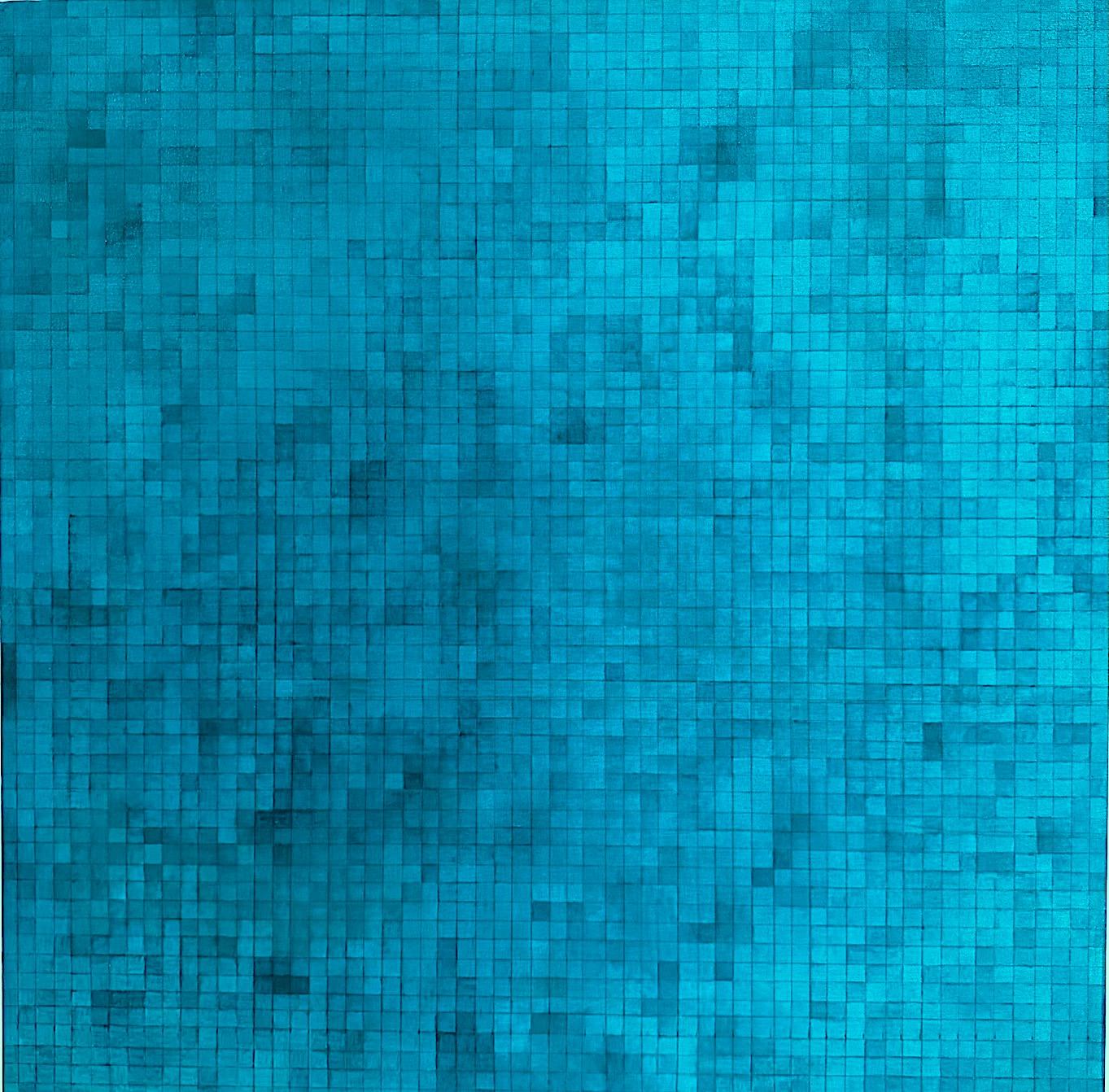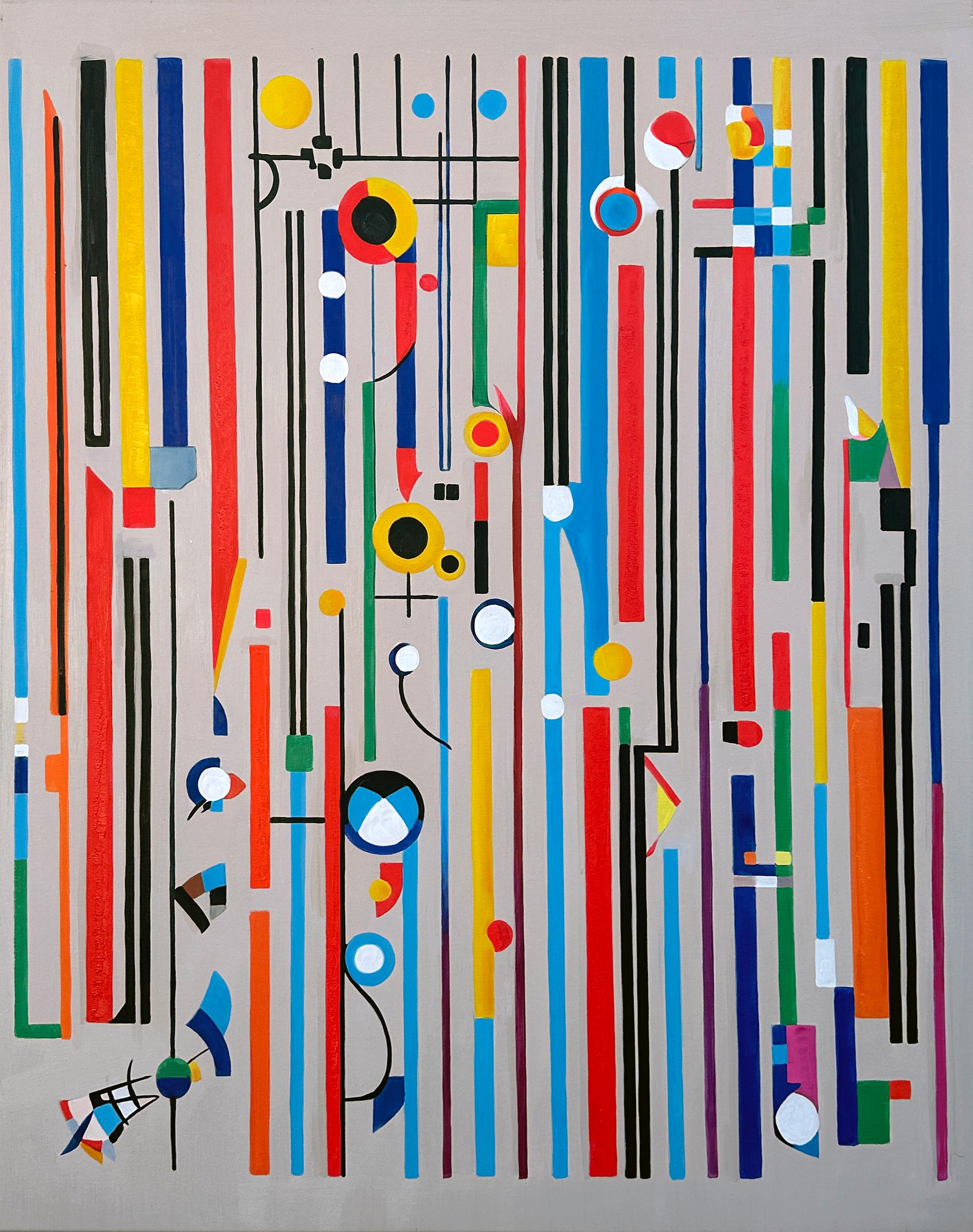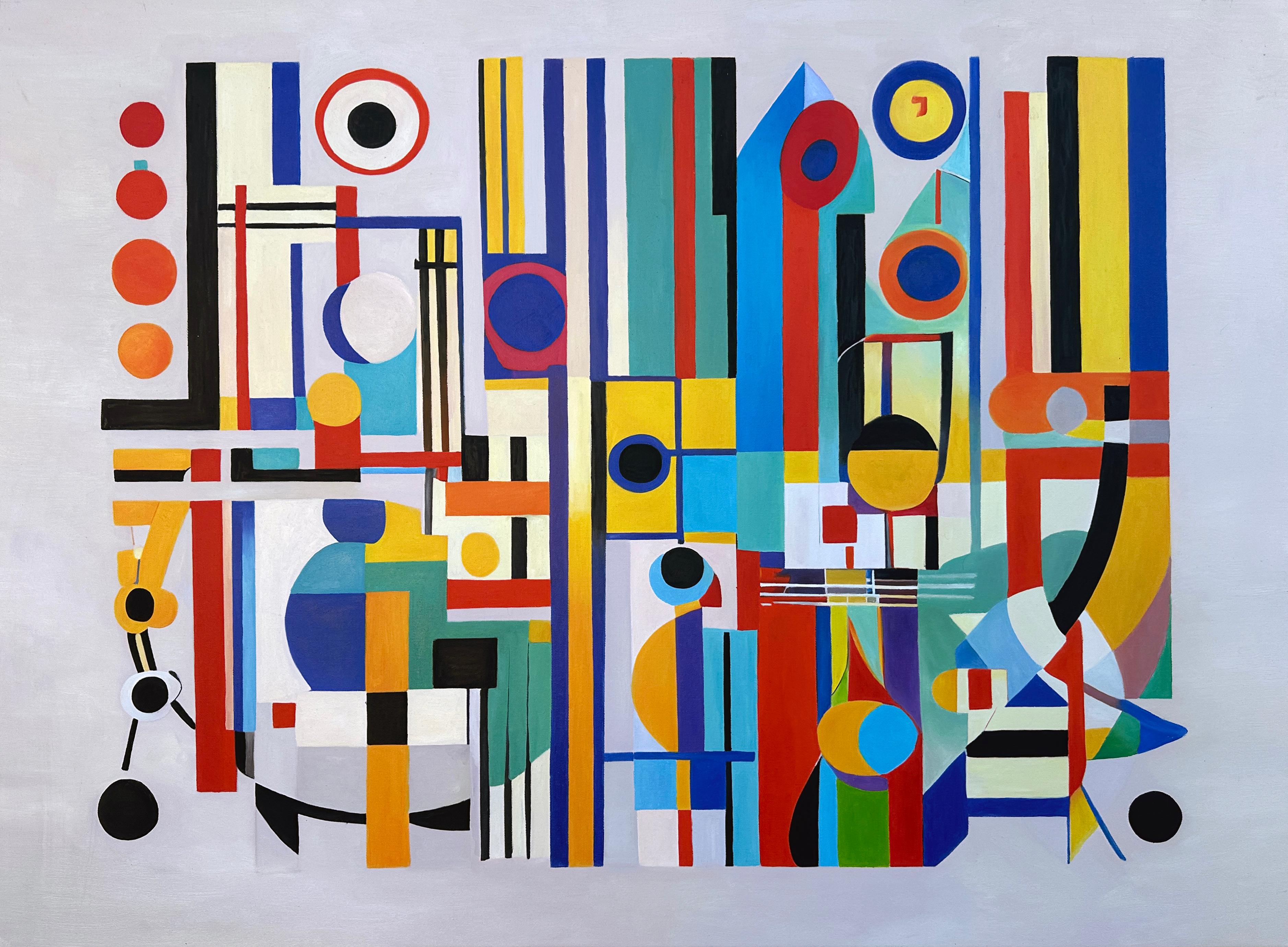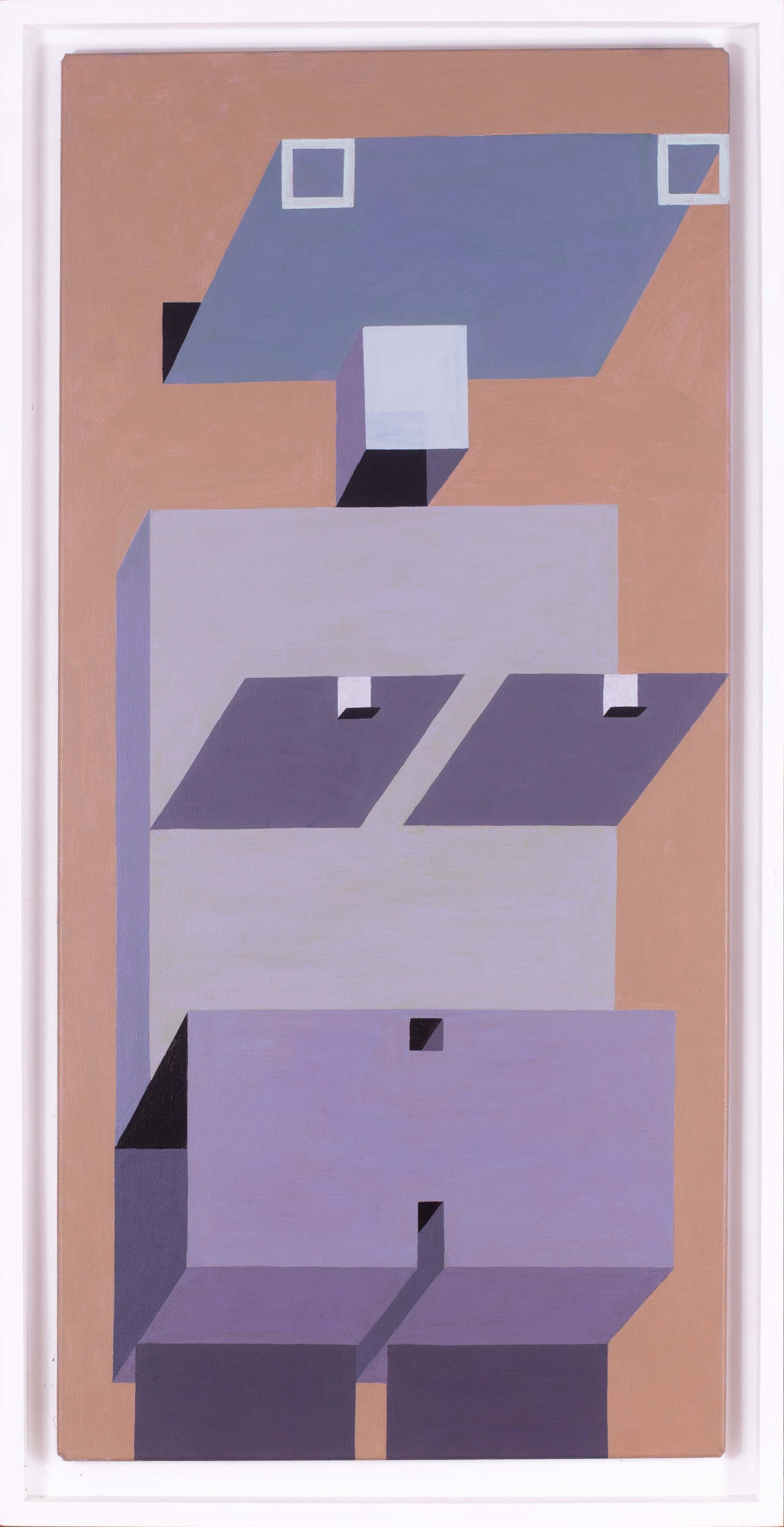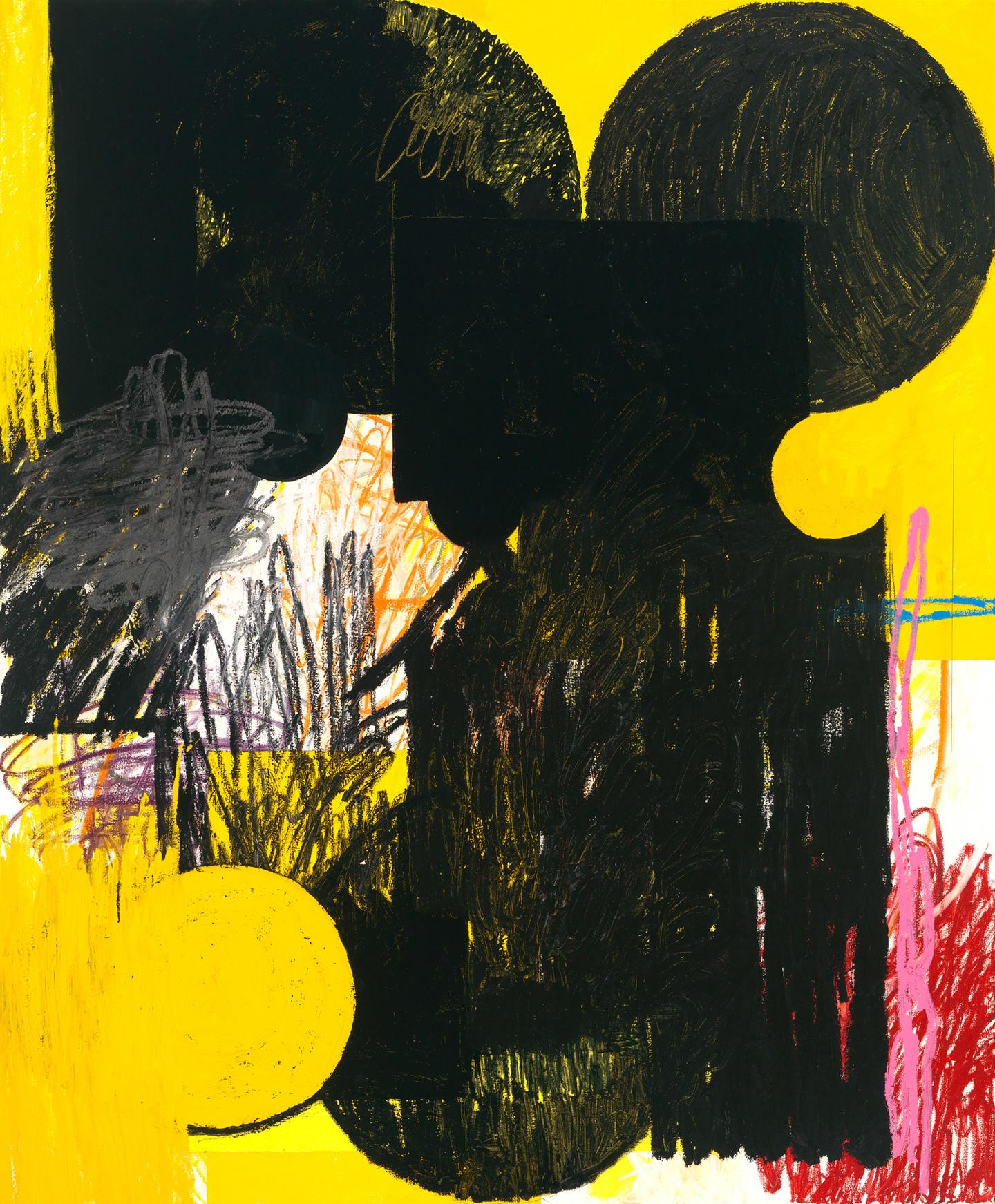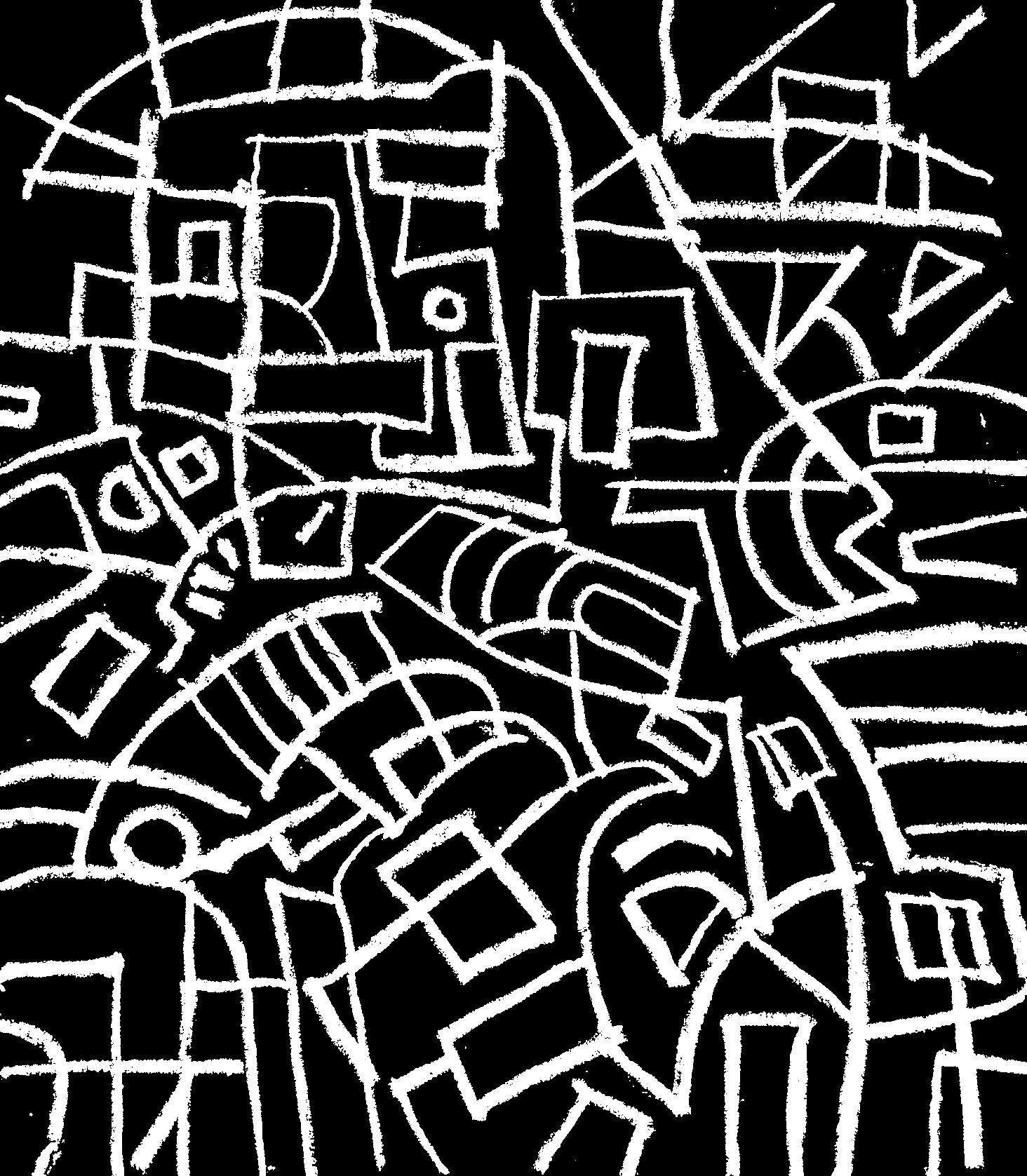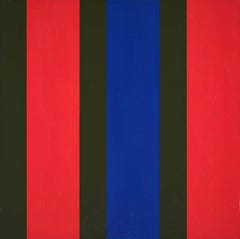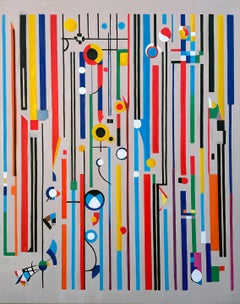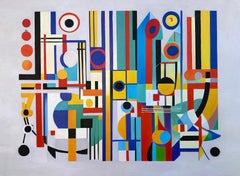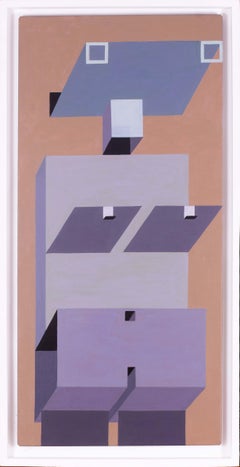Items Similar to "Twice Told Tale (3)" David Shapiro, Rare Oil on Canvas Symbolic Composition
Want more images or videos?
Request additional images or videos from the seller
1 of 6
David Shapiro"Twice Told Tale (3)" David Shapiro, Rare Oil on Canvas Symbolic Composition1983
1983
About the Item
David Shapiro
Twice Told Tale (3), 11/1983
Signed and dated on verso
Oil on canvas
44 x 22 inches
David Shapiro was born in 1944 in Brooklyn, New York. His artwork, as described by author Mason Riddle, embodies a deeply personal lexicon of signs and symbols. Elements such as circles, spirals, dots, and various wave and knot patterns, along with stylized flames and textures, resonate on richly colored, tactile surfaces made from Nepalese and Japanese papers, burlap, nylon screening, and canvas, evoking a nuanced atmosphere of reflection. These pieces suggest constellations of celestial bodies or the intricacies of human thought, visually and psychologically intersecting, overlapping, and merging with one another. Often compared to the visual representation of a mantra, Shapiro creates series of works inspired by Eastern traditions and concepts, including "Mudra" (Buddhist hand symbols) and "Savasan" (the reclining position in yoga practices).
Shapiro’s work is included in many public and private collections including The Museum of Modern Art, the Solomon Guggenheim Museum; the San Francisco Museum of Modern Art; the Cleveland Museum of Art, and the Kunsthalle der Stadt in Nuremberg, Germany.
- Creator:David Shapiro (1944, American)
- Creation Year:1983
- Dimensions:Height: 46 in (116.84 cm)Width: 24 in (60.96 cm)
- More Editions & Sizes:Unique WorkPrice: $25,000
- Medium:
- Movement & Style:
- Period:
- Condition:
- Gallery Location:New York, NY
- Reference Number:1stDibs: LU1841215803072
About the Seller
5.0
Gold Seller
Premium sellers maintaining a 4.3+ rating and 24-hour response times
Established in 2022
1stDibs seller since 2022
98 sales on 1stDibs
Typical response time: <1 hour
- ShippingRetrieving quote...Shipping from: New York, NY
- Return Policy
Authenticity Guarantee
In the unlikely event there’s an issue with an item’s authenticity, contact us within 1 year for a full refund. DetailsMoney-Back Guarantee
If your item is not as described, is damaged in transit, or does not arrive, contact us within 7 days for a full refund. Details24-Hour Cancellation
You have a 24-hour grace period in which to reconsider your purchase, with no questions asked.Vetted Professional Sellers
Our world-class sellers must adhere to strict standards for service and quality, maintaining the integrity of our listings.Price-Match Guarantee
If you find that a seller listed the same item for a lower price elsewhere, we’ll match it.Trusted Global Delivery
Our best-in-class carrier network provides specialized shipping options worldwide, including custom delivery.More From This Seller
View All"DK. Green, Scarlet, Blue" Oli Sihvonen, Abstract Vertical Geometric Composition
Located in New York, NY
Oli Sihvonen
DK. Green, Scarlet, Blue, circa 1977
Signed and titled on the reverse
Acrylic on canvas
36 x 36 inches
Known for large, hard-edged abstractions, Oli T. Sihvonen, a Bro...
Category
1970s Abstract Geometric Abstract Paintings
Materials
Canvas, Acrylic
"Jean Jean" Larry Zox, Color Field, Geometric Abstraction, Hard-Edge, Yellow
By Larry Zox
Located in New York, NY
Larry Zox
Jean Jean, 1964
Signed, dated, and titled on the stretcher
Liquitex on canvas
58 x 62 inches
Provenance:
Solomon & Co., New York
Private Collection, NJ
Estate of the above, 2023
Committed to abstraction throughout his career, Larry Zox played a central role in the Color Field discourse of the 1960s and 1970s. His work of the time, consisting of brilliantly colored geometric shapes in dynamic juxtapositions, demonstrated that hard-edge painting was neither cold nor formalistic. He reused certain motifs, but he did so less to explore their aspects than to “get at the specific character and quality of each painting in and for itself,” as James Monte stated in his essay for Zox’s solo exhibition at the Whitney Museum of American Art in 1973. By the 1970s, Zox was using a freer, more emotive method, while maintaining the autonomy of color, which increasingly became more important to him than structure in his late years.
Zox began to receive attention in the 1960s, when he was included in several groundbreaking exhibitions of Color Field and Minimalist art, including Shape and Structure (1965), organized by Henry Geldzahler for the Gallery of Modern Art, New York, and Systemic Painting (1966), organized by Lawrence Alloway for the Guggenheim Museum. In 1973, the Whitney’s solo exhibition of Zox’s work gave recognition to his significance in the art scene of the preceding decade. In the following year, Zox was represented in the inaugural exhibition of the Hirshhorn Museum, which owns fourteen of his works.
Zox was born in Des Moines, Iowa. He attended the University of Oklahoma and Drake University. While studying at the Des Moines Art Center, he was mentored by George Grosz, who despite his own figurative approach encouraged Zox’s forays into abstraction. In 1958, Zox moved to New York, joining the downtown art scene. His studio on 20th Street became a gathering place for artists, jazz musicians, bikers, and boxers. He occasionally sparred with the visiting fighters. He later established a studio in East Hampton, where he painted and fished including using a helicopter to spot fish.
In the 1950s and early 1960s, Zox’s works were collages consisting of painted pieces of paper stapled onto sheets of plywood. He then produced paintings that were illusions of collages, including both torn- and trued-edged forms, to which he added a wide range of intense hues that created ambiguous surfaces. Next, he omitted the collage aspect of his work and applied flat color areas to create more complete statements of pure color and shape.
From 1962 to 1965, he produced his Rotation Series, at first creating plywood and Plexiglas reliefs, which turned squares into dynamic polygons. He used these shapes in his paintings as well, employing white as a foil between colors to produce negative spaces that suggest that the colored shapes had only been cut out and laid down instead of painted. The New York Times noted in 1964: “The artist is hip, cool, adventurous, not content to stay with the mere exercise of sensibility that one sees in smaller works.”
In 1965, he began the Scissors Jack...
Category
1960s Abstract Geometric Abstract Paintings
Materials
Canvas, Acrylic
$64,000 Sale Price
20% Off
"Untitled" Dan Christensen, Geometric Plaid Series, Orange and Blue Abstract
By Dan Christensen
Located in New York, NY
Dan Christensen
Untitled, circa 1970-71
Acrylic and enamel on canvas
44 x 20 inches
Provenance:
The artist
Sherron Francis (gift from the above)
Dan Christensen was an American abs...
Category
1970s Abstract Geometric Abstract Paintings
Materials
Enamel
"Ouverture, with Cypress Forms" Stephen Edlich, Abstract Geometric Painting
By Stephen Edlich
Located in New York, NY
Stephen Edlich
Ouverture, with Cypress Forms, 1982
Signed, dated and titled on the stretcher
Acrylic paint, mixed media, and burlap on canvas
60 x 40 inches
An artist who worked in the post-cubist and constructivist traditions, Stephen P. Edlich gained a considerable amount of acclaim in the 1970s and 1980s for his collages, sculpture, and paintings. His promising career was cut short due to his untimely death at age 45 in 1989.
Edlich was born in New York City. He received his undergraduate degree with a major in fine arts studies from New York University in 1967. During his college years, he traveled to London, where he met the art dealer Victor Waddington and created his first white on white collage. In that same year, he attended a major exhibition of the work of Ben Nicholson, which would be influential source in his art. Edlich returned to England in 1967, where he met Barbara Hepworth and Patrick Heron in London and traveled to St. Ives, Cornwall, long a favorite artists' haunt. Edlich began creating acrylic reliefs...
Category
1980s Abstract Geometric Abstract Paintings
Materials
Canvas, Burlap, Mixed Media, Acrylic
$60,000 Sale Price
20% Off
"Untitled, " Seymour Fogel, Geometric Abstraction, Texas Hard-Edge
By Seymour Fogel
Located in New York, NY
Seymour Fogel
Untitled
Oil on illustration board construction
10 x 7 1/2 inches
Provenance:
Estate of the artist
Charles and Faith McCracken
Larry and Trish Heichel
Private Collection
Seymour Fogel was born in New York City on August 24, 1911. He studied at the Art Students League and at the National Academy of Design under George Bridgeman and Leon Kroll. When his formal studies were concluded in the early 1930s he served as an assistant to Diego Rivera who was then at work on his controversial Rockefeller Center mural. It was from Rivera that he learned the art of mural painting.
Fogel was awarded several mural commissions during the 1930s by both the Works Progress Administration (WPA) and the Treasury Section of Fine Arts, among them his earliest murals at the Abraham Lincoln High School in Brooklyn, New York in 1936, a mural in the WPA Building at the 1939-1940 New York World's Fair, a highly controversial mural at the U.S. Post Office in Safford, Arizona (due to his focus on Apache culture) in 1941 and two murals in what was then the Social Security Building in Washington, D.C., also in 1941. Fogel's artistic circle at this time included Phillip Guston, Ben Shahn, Franz Kline, Rockwell Kent and Willem de Kooning.
In 1946 Fogel accepted a teaching position at the University of Texas at Austin and became one of the founding artists of the Texas Modernist Movement. At this time he began to devote himself solely to abstract, non-representational art and executed what many consider to be the very first abstract mural in the State of Texas at the American National Bank in Austin in 1953. He pioneered the use of Ethyl Silicate as a mural medium. Other murals and public works of art done during this time (the late 1940s and 1950s) include the Baptist Student Center at the University of Texas (1949), the Petroleum Club in Houston (1951) and the First Christian Church, also in Houston (1956), whose innovative use of stained glass panels incorporated into the mural won Fogel a Silver Medal from the Architectural League of New York in 1958.
Fogel relocated to the Connecticut-New York area in 1959. He continued the Abstract Expressionism he had begun exploring in Texas, and began experimenting with various texturing media for his paintings, the most enduring of which was sand. In 1966 he was awarded a mural at the U.S. Federal Building in Fort Worth, Texas. The work, entitled "The Challenge of Space", was a milestone in his artistic career and ushered in what has been termed the Transcendental/Atavistic period of his art, a style he pursued up to his death in 1984. Painted and raw wood sculpture...
Category
Mid-20th Century Abstract Geometric Abstract Paintings
Materials
Oil, Board
$4,600 Sale Price
20% Off
"Harvard vs Yale" Charles Green Shaw, Football, Ivy League Sports, Abstract
By Charles Green Shaw
Located in New York, NY
Charles Green Shaw
Harvard vs. Yale, 1944
Signed and dated on the reverse
Oil on canvasboard
9 x 12 inches
Provenance:
Harvey and Francois Rambach, New Jersey
Private Collection, California
Washburn Gallery, New York
D. Wigmore Fine Art, New York
Private Collection, New York
Charles Green Shaw, born into a wealthy New York family, began painting when he was in his mid-thirties. A 1914 graduate of Yale, Shaw also completed a year of architectural studies at Columbia University. During the 1920s Shaw enjoyed a successful career as a freelance writer for The New Yorker, Smart Set and Vanity Fair, chronicling the life of the theater and café society. In addition to penning insightful articles, Shaw was a poet, novelist and journalist. In 1927 he began to take a serious interest in art and attended Thomas Hart Benton's class at the Art Students League briefly in New York. He also studied privately with George Luks, who became a good friend. Once he had dedicated himself to non-traditional painting, Shaw's writing ability made him a potent defender of abstract art.
After initial study with Benton and Luks, Shaw continued his artistic education in Paris by visiting numerous museums and galleries. From 1930 to 1932 Shaw's paintings evolved from a style imitative of Cubism to one directly inspired by it, though simplified and more purely geometric. Returning to the United States in 1933, Shaw began a series of abstracted cityscapes of skyscrapers he called Manhattan Motifs which evolved into his most famous works, the shaped canvases he called Plastic Polygons.
The 1930s were productive years for Shaw. He showed his paintings in numerous group exhibitions, both in New York and abroad, and was also given several one-man exhibitions. Shaw had his first one-man exhibition at the Valentine Dudensing Gallery in New York in 1934, which included 25 Manhattan Motif paintings and 8 abstract works. In the spring of 1935 Shaw was introduced to Albert Gallatin and George L.K. Morris. Gallatin was so impressed with Shaw's work, he broke a policy against solo exhibitions at his museum, the Gallery of Living Art, and offered Shaw an exhibition there. In the summer of 1935 Shaw traveled to Paris with Gallatin and Morris who provided introductions to many great painters. Shaw regularly spent time with John Ferren and Jean Hélion. The following year Gallatin organized an exhibition called Five Contemporary American Concretionists at the Reinhardt Gallery that included Shaw, Ferren, and Morris, Alexander Calder, and Charles Biederman...
Category
1940s Abstract Geometric Landscape Paintings
Materials
Oil, Board
$28,000 Sale Price
20% Off
You May Also Like
Blue - 30 x 30 inches - oil on canvas
By Gloria Matuszewski
Located in Burlingame, CA
'Blue' glows with serene aqua blue. The abstract meditative painting is inspired by Taoist teachings and meditations, with a focus on color, rhythm and flow. Matuszewski creates medi...
Category
21st Century and Contemporary Abstract Geometric Abstract Paintings
Materials
Canvas, Oil, Graphite
Finding You Lilly Muth - Contemporary geometric abstraction - Oil Painting
Located in DE
Lilly Muth's geometric abstractions are colourful works full figures that of space such as the distance, shape, size, and relative position of figures. Her use of colour is bold yet ...
Category
21st Century and Contemporary Abstract Geometric Abstract Paintings
Materials
Canvas, Oil
Loving Life Lilly Muth - Contemporary geometric abstraction - Oil Painting
Located in DE
Lilly Muth's geometric abstractions are colourful works full figures that of space such as the distance, shape, size, and relative position of figures. Her use of colour is bold yet ...
Category
21st Century and Contemporary Abstract Geometric Abstract Paintings
Materials
Canvas, Oil
British Abstract geometric figure in greys by Ron Sims
Located in Petworth, West Sussex
Ron Sims (British, 1944 – 2014)
Ghost
Oil on canvas
48.1/4 x 22.5/8 in. (122.5 x 57.5 cm.)
Category
20th Century Abstract Geometric Figurative Paintings
Materials
Canvas, Oil
Eclipse
By Javier Arizmendi-Kalb
Located in Burlingame, CA
Mexican-American visual artist Javier Arizmendi-Kalb’s expressive and texturally rich paintings are
nuanced with symbolic and narrative motif in oil a...
Category
21st Century and Contemporary Abstract Geometric Paintings
Materials
Oil Crayon, Cotton Canvas, Oil
Mass Hysteria, Chalkboard Series, Abstract Geometric Line Painting
By Robert Petrick
Located in Los Angeles, CA
Robert Petrick's "Mass Hysteria" is a fusion of meticulous geometry and bold abstract expression. From the artist's Chalkboard Series, this piece is both timeless and contemporary, o...
Category
21st Century and Contemporary Abstract Geometric Abstract Paintings
Materials
Canvas, Oil
